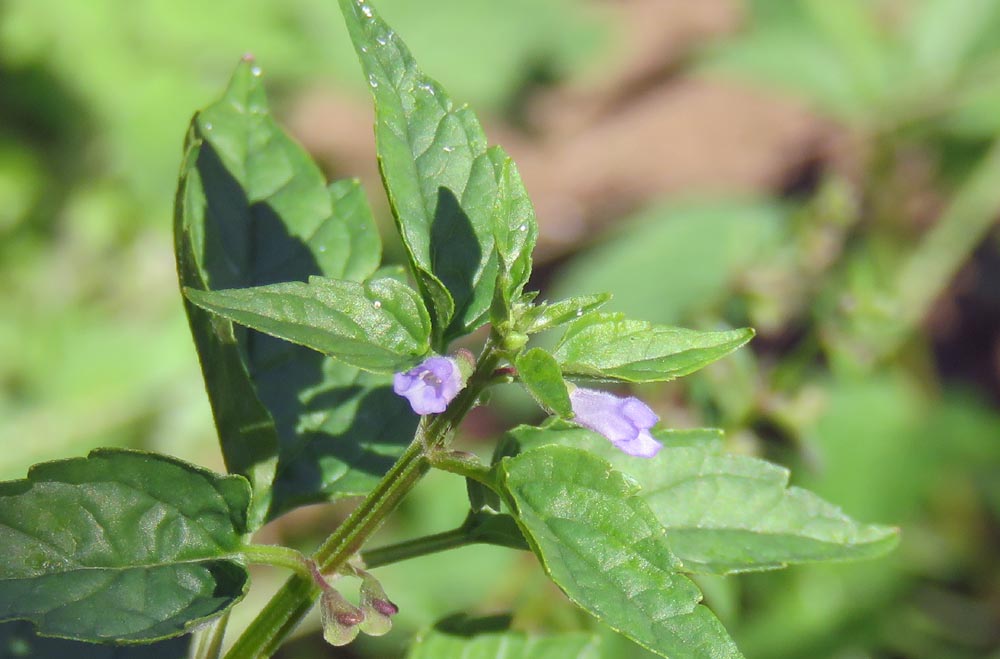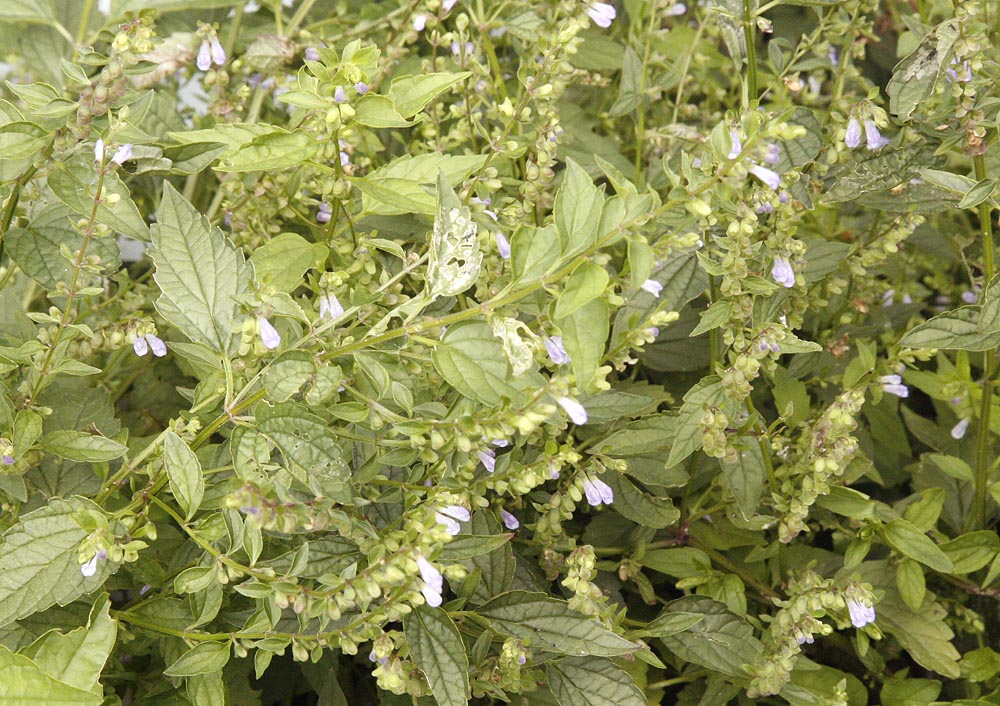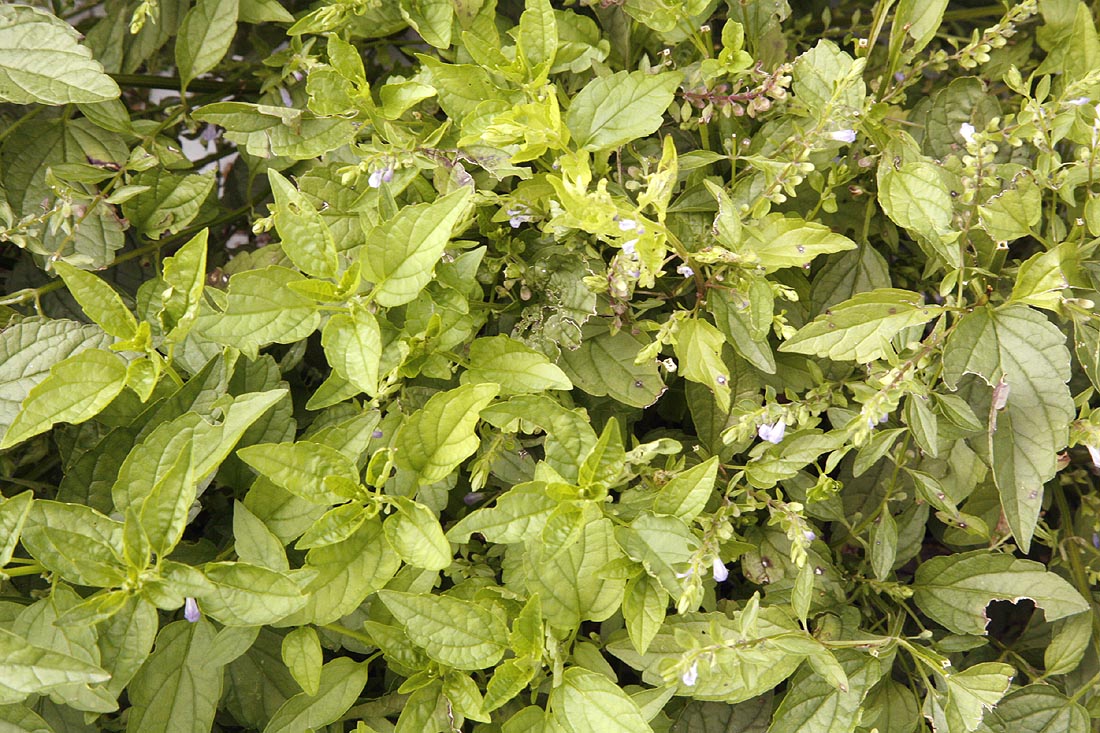A low growing plant that loves moisture. Ideal for sunny wet spots this perennial is hardy to zone 4. It will grow in most soil types and even tolerate semi dry soils but then it may act as an annual rather than a perennial. Low growing with bright green leaves and small blue flowers that open along one side of long stems that grow from all the leaf nodes. Can form sprawling colonies and root along the stems in suitable moist soil making a good ground cover. The leaves are bitter so wildlife don't eat them but bumblebees and hummingbirds love the flowers. Easy to grow and takes very little maintenance once established, just cut down all the dead stuff in winter. Powerful nervine herb that is used to treat myriad of nervous complaints great little plant to have around the garden.
Description of Side flowering Skullcap (Scutellaria lateriflora).
Perennial plant hardy to zone 4 dies back in winter. In spring the bright green shoots appear and produce a branching sometimes upright sometimes slightly sprawling plant about 24 inches (61cm) tall. Long thin square stems support opposite pairs of leaves throughout its length. These differ in size and shape. The lower leaves, which were first to form in spring are larger bright green and about 2.5 inches (6.2 cm) long and 1.5 inches (3.7cm) wide, scalloped edges, ovate in shape with pointed tips. These leaves tend to wilt away my mid summer leaving only the smaller leaves on the erect stems. These tend to me smaller and more lance shaped. all eaves have deep noticeable veins giving them strong character.
Flower stalks arise from the leaf nodes as long slightly curved 'branches' up to 6 inches (15.24 cm) long and support a line of flowers. Each flower is about 0.3 inches (8mm) in length and is basically tubular in both the corolla and calyx (petals and base) and appears trumpet shaped. This 'petal tube' can be pale blue, lavender or white with blue being the most common color. Flowers are on only one side of the stem giving rise to the common name 'side flowering'. Flowers open in ones and twos along the stem with no apparent pattern. They are followed by small brown seed capsules. The whole plant is bitter tasting.
Growing Side flowering Skullcap (Scutellaria lateriflora) from Seed.
Seeds need a period of cold before they will germinate. All our seeds are kept cold before shipping so this process is already started. Place seeds in the refrigerator as soon as they arrive and keep them their until ready to sow. Many sources suggest that moist stratification is necessary before seeds will germinate. We have found that most seeds will germinate if just kept cold enough before sowing. However not all seeds will germinate this way. If you want to ensure very high germination then moist stratify before planting see our Stratification instructions to determine the best method for you. Germination is always slow and erratic even after moist stratification so be patient.
Sow seeds in small pots or cell trays so each seed has its own space. This way those that germinate first can be transplanted without disturbing the still slumbering seed-mates. Give them good light, warmth and keep moist. Transplant to larger pots when they are large enough to handle and grow on until about 3 inches (7.6cm) in height before transplanting out after danger of frost has past.
If you have a sunny wet or damp spot in your garden then this is the place to plant skullcap. It will also do well in rain gardens provided there is sufficient rainfall throughout the summer months. If not it will need watering.
Tolerates almost all soil types but does best on those that retain water. Needs full sun but can tolerate some light shade in warmer zones. If growing as warm as zone 9 then more water and shade will be necessary.
If the location is too dry Skullcap may act as an annual and die at the end of the year.
Due to its bitter nature its not eaten by wildlife.
For cut flowers. Chose stems that have just begin to open, strip off the foliate and place in water immediate. makes good filler flower.








